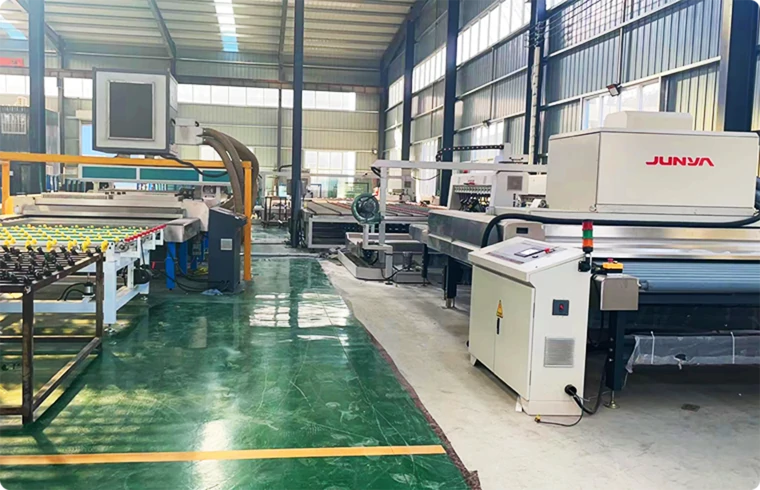The Allure of Green Reflective Glass Windows
In recent years, the architectural world has seen a resurgence in the use of green reflective glass windows, a trend that marries aesthetics with functionality. This distinctive feature not only enhances the visual appeal of buildings but also contributes to energy efficiency and environmental sustainability. As cities grow and the quest for sustainable design intensifies, green reflective glass is becoming a favored choice among architects and designers.
Green reflective glass is a type of glazing that has a green tint, achieved through the addition of specific metal oxides during the manufacturing process. This unique coloration isn’t merely for visual flair; it also serves practical purposes. The reflective quality of the glass allows buildings to blend seamlessly into lush landscapes, minimizing their visual impact and creating a harmonious connection with nature. This aspect is particularly vital in urban settings where green spaces are scarce.
One of the most significant benefits of green reflective glass windows is their ability to reduce solar heat gain. In regions with high sun exposure, traditional windows can lead to increased cooling costs as air conditioning systems work overtime to regulate indoor temperatures. The reflective nature of green glass minimizes the amount of sunlight entering a building, thus maintaining a comfortable environment. This not only helps in reducing energy consumption but also contributes to lowering greenhouse gas emissions, making it an environmentally friendly option.
In addition to thermal insulation, green reflective glass provides superior UV protection. Ultraviolet rays can cause fading in furnishings, artwork, and flooring, leading to costly replacements and diminished aesthetic appeal. By incorporating this type of glass into building designs, architects can protect the interior by filtering harmful UV rays, prolonging the life of interior elements while also adding to the comfort of occupants.
The aesthetic appeal of green reflective glass cannot be overstated. Modern architecture often seeks to create a dialogue between the built environment and its natural surroundings. The green hues of the glass can mimic the colors of foliage and trees, creating a visually soothing effect. As light interacts with the surface of the glass, it produces varying shades and reflections that change throughout the day, offering a dynamic visual experience that breathes life into building facades.
green reflective glass window
Furthermore, the use of green reflective glass enhances privacy without compromising natural light. While maintaining transparency, the reflective quality ensures that outsiders cannot easily see inside, allowing occupants to enjoy their personal spaces without feeling exposed. This feature is particularly appealing for commercial properties, offices, and residential buildings situated in bustling urban environments.
From an economic standpoint, the integration of green reflective glass windows can lead to significant savings in both construction and operational costs. Though the initial investment in high-performance glazing can be higher than traditional options, the long-term savings in energy bills and maintenance often offset the upfront costs. Buildings equipped with energy-efficient features are also more attractive to potential buyers and tenants, thereby increasing property values and occupancy rates.
Moreover, in a world that is becoming increasingly focused on sustainability, the use of green reflective glass aligns with the principles of green building practices. Many green certification programs, such as LEED (Leadership in Energy and Environmental Design), recognize the benefits of using reflective glass as part of a strategy to enhance overall building performance. These certifications can elevate a building’s status, making it more appealing in a competitive real estate market.
As we look toward the future of design and architecture, the role of materials like green reflective glass will undoubtedly continue to grow. With advancements in technology and manufacturing, these windows will become even more efficient and versatile, offering innovative solutions to a variety of architectural challenges. Embracing such materials not only reflects a commitment to sustainable practices but also signifies an understanding of the need for structures that respect and enhance their environments.
In conclusion, green reflective glass windows stand at the intersection of beauty, functionality, and sustainability. They are a powerful tool for architects and designers striving to create spaces that are not only visually stunning but also energy-efficient and eco-friendly. As this trend continues to evolve, it promises to reshape the landscape of modern architecture, fostering a deeper connection between buildings and the natural world around them.
 Afrikaans
Afrikaans  Albanian
Albanian  Amharic
Amharic  Arabic
Arabic  Armenian
Armenian  Azerbaijani
Azerbaijani  Basque
Basque  Belarusian
Belarusian  Bengali
Bengali  Bosnian
Bosnian  Bulgarian
Bulgarian  Catalan
Catalan  Cebuano
Cebuano  Corsican
Corsican  Croatian
Croatian  Czech
Czech  Danish
Danish  Dutch
Dutch  English
English  Esperanto
Esperanto  Estonian
Estonian  Finnish
Finnish  French
French  Frisian
Frisian  Galician
Galician  Georgian
Georgian  German
German  Greek
Greek  Gujarati
Gujarati  Haitian Creole
Haitian Creole  hausa
hausa  hawaiian
hawaiian  Hebrew
Hebrew  Hindi
Hindi  Miao
Miao  Hungarian
Hungarian  Icelandic
Icelandic  igbo
igbo  Indonesian
Indonesian  irish
irish  Italian
Italian  Japanese
Japanese  Javanese
Javanese  Kannada
Kannada  kazakh
kazakh  Khmer
Khmer  Rwandese
Rwandese  Korean
Korean  Kurdish
Kurdish  Kyrgyz
Kyrgyz  Lao
Lao  Latin
Latin  Latvian
Latvian  Lithuanian
Lithuanian  Luxembourgish
Luxembourgish  Macedonian
Macedonian  Malgashi
Malgashi  Malay
Malay  Malayalam
Malayalam  Maltese
Maltese  Maori
Maori  Marathi
Marathi  Mongolian
Mongolian  Myanmar
Myanmar  Nepali
Nepali  Norwegian
Norwegian  Norwegian
Norwegian  Occitan
Occitan  Pashto
Pashto  Persian
Persian  Polish
Polish  Portuguese
Portuguese  Punjabi
Punjabi  Romanian
Romanian  Russian
Russian  Samoan
Samoan  Scottish Gaelic
Scottish Gaelic  Serbian
Serbian  Sesotho
Sesotho  Shona
Shona  Sindhi
Sindhi  Sinhala
Sinhala  Slovak
Slovak  Slovenian
Slovenian  Somali
Somali  Spanish
Spanish  Sundanese
Sundanese  Swahili
Swahili  Swedish
Swedish  Tagalog
Tagalog  Tajik
Tajik  Tamil
Tamil  Tatar
Tatar  Telugu
Telugu  Thai
Thai  Turkish
Turkish  Turkmen
Turkmen  Ukrainian
Ukrainian  Urdu
Urdu  Uighur
Uighur  Uzbek
Uzbek  Vietnamese
Vietnamese  Welsh
Welsh  Bantu
Bantu  Yiddish
Yiddish  Yoruba
Yoruba  Zulu
Zulu 

